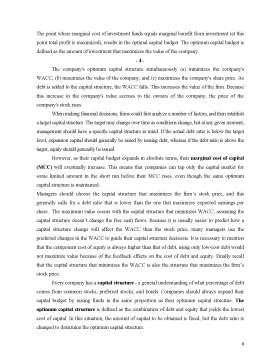Extras din curs
The long-term investments made today will determine the value of the business tomorrow. In order to make long-term investments in new product lines, new equipment and other assets, managers must know the cost of obtaining funds to acquire these assets. The cost associated with different sources of funds is called the cost of capital. Cost of Capital represents the rate a business must pay for each source of funds - debt, preferred stock, common stock, and retained earnings. This is from the firm’s point of view; where the cost of capital is what the firm must pay for the funds needed to finance an Investment.
Also, the cost of capital represents the return that must be provided for the use of an investor’s funds. If funds are borrowed, the cost is related to the interest that must be paid on the loan. If the funds are equity, the cost is the return that investors expect, both from the stock’s price appreciation and dividends. So, from the investor’s point of view, the cost of capital is the same as the required rate of return.
The cost of capital may be an explicit cost (for ex., the interest paid on debt) or an implicit cost (for ex., the expected price appreciation of shares of the firm’s common stock).
The cost of capital is a critical element in investment decision. It acts as a major link between the firm’s investment decision and the wealth of the owners as determined by investors. It is the number used to decide whether a proposed investment will increase or decrease the firm’s stock price. Only those projects expected to increase stock price would be accepted. The cost of capital is the minimum rate of return that a project must yield in order to be accepted by a company. This minimum rate of return is sometimes called the discount rate or the required rate of return.
The required rate of return is determined by the opportunity cost, which is the return which could have been received on an investment with similar risk. In other words, the cost of capital represents the investors' opportunity cost of taking on the risk of putting money into a company.
The opportunity cost of capital is a term used to describe the forgone opportunity of using cash. It depends on whether the cash has another use and whether it is replaceable. Cash always has another use. If no other investments are available, it can be used to retire debt or pay dividends to the owners. Therefore the opportunity cost of capital is the replacement cost of cash or the cost of borrowing that is the interest payment or cost of issuing shares that is the expected return to shareholders. It also represents the return that could have been received on an investment with similar risk. The opportunity Cc is described in terms of percentage return or interest rate.
When we refer to the cost of capital for a firm, we are usually referring to the cost of financing its assets. In other words, we mean the cost of capital for all the firm’s projects taken together and, hence, the cost of capital for the average project risk of the firm.
When we refer to the cost of capital of a project, we are referring to the cost of capital that reflects the risk of that project. So, determining the cost of capital for the firm as a whole it is essential for two reasons.
First, the cost of capital for the firm is often used as a starting point for determining the cost of capital for a specific project. The firm’s cost of capital is adjusted upward or downward depending on whether the project’s risk is more or less than the firm’s typical project.
Second, many of firm’s projects have risk similar to the risk of the firm as a whole. So the cost of the capital of the firm is a reasonable approximation for the cost of capital of one of its projects that are under consideration for investment.
A firms cost of capital is the cost of its long-term sources of funds: debt, preferred stock, and common stock. And the cost of each source reflects the risk of the assets the firm invests in. A firm that invests in assets having little risk will be able to bear lower costs of capital than a firm that invests in assets having a high risk. Moreover, the cost of each source of funds reflects the hierarchy (pecking order) of the risk associated with the seniority over the other sources.
The specific pecking order (in increasing order of their cost) is as follows:
1. Internal sources of capital – income before taxes, depreciation
2. External sources of capital – debt (credits, bonds, treasury securities)
3. Internal sources of capital- retained earnings
4. External sources of capital - preferred stock
5. External sources of capital - common stock
This hierarchy is determined by the risk of each source of capital, the priority in taking promised interests and the size of required return.
Preview document
Conținut arhivă zip
- The Cost of Capital.doc
























